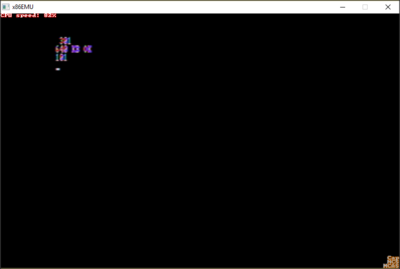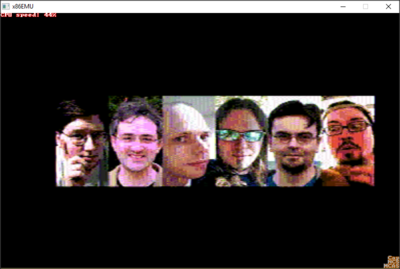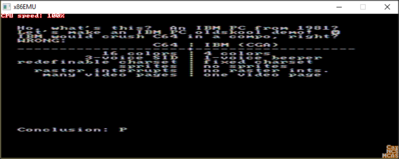Reply 140 of 187, by superfury
Here are the logs of 4 parts of the demo:
The first dump period is the CGA style screen (old vs new cga).
The second dump is the 4k screen showing CGA colors(ugly).
The third dump is the 4k screen showing 16 colors.
The fourth dump is the 4k screen showing 1K colors.
Is this good enough?
About the DMA controller: it's not 100% implemented, since PC software shouldn't be using all features?
The basic register addresses are implemented.
The registers for I/O ports 0x00-0x0F(DMA #1), 0xC0-0xCF(DMA #2) and ports 0x81-0x83, 0x87(DMA 1), 0x89-0x8B and 0x8F(DMA 2) are implemented.
As for the modes, only part of the modes are implemented:
- Controller disabled is implemented.
- Mode 3 channels are skipped.
The handling of the transfers:
void DMA_tick(){if (__HW_DISABLED) return; //Abort!register byte controller; //Current controller!register byte channelindex, MCMReversed;byte transferred = 0; //Transferred data this time?byte startcurrent = current; //Current backup for checking for finished!nextcycle: //Next cycle to process!controller = ((current&4)>>2); //Init controllerif (DMAController[controller].CommandRegister&4) goto nextchannel; //Controller disabled?byte channel = (current & 3); //Channel to use! Channels 0 are unused (DRAM memory refresh (controller 0) and cascade DMA controller (controller 1))//Handle the current channel, since the controller is enabled!DMAModeRegister moderegister;moderegister.data = DMAController[controller].DMAChannel[channel].ModeRegister.data; //Read the mode register to use!if (moderegister.Mode==3) goto nextchannel; //Skip channel: invalid! We don't process a cascade mode channel!if (DMAController[controller].DMAChannel[channel].DREQHandler) //Gotten a tick handler?{DMAController[controller].DMAChannel[channel].DREQHandler(); //Execute the tick handler!}channelindex = 1; //Load index!channelindex <<= channel; //Assign the channel index to use!MCMReversed = DMAController[controller].MultiChannelMaskRegister; //Load MCM!MCMReversed = ~MCMReversed; //NOT!MCMReversed &= channelindex; //For our current channel only!if (DMAController[controller].DREQ&MCMReversed) //Requested and not masking?{if (DMAController[controller].DMAChannel[channel].DACKHandler) //Gotten a DACK handler?{DMAController[controller].DMAChannel[channel].DACKHandler(); //Send a DACK to the hardware!}switch (moderegister.Mode){case 0: //Single transfer!case 1: //Block transfer!DMAController[controller].DACK |= channelindex; //Acnowledged!break;case 2: //Demand transfer?//Nothing happens: DREQ affects transfers directly!break;}}byte processchannel = 0; //To process the channel?switch (moderegister.Mode) //What mode?{case 0: //Demand mode?//DREQ determines the transfer!processchannel = DMAController[controller].DREQ;processchannel &= channelindex; //Demand sets if we're to run!break;case 1: //Single: DACK determines running time!case 2: //Block: TC and DREQ masked determines running time!//DACK isn't used in this case!processchannel = DMAController[controller].DACK;processchannel &= MCMReversed; //We're affected directly by the DACK!
break;}if (DMAController[controller].RequestRegister&channelindex) //Requested?{processchannel = 1; //Process: software request!}if (processchannel) //Channel not masked off and requested?{transferred = 1; //We've transferred a byte of data!byte processed = 0; //Default: nothing going on!/*processed bits:bit 0: TC (Terminal Count) occurred.*///Calculate the address...uint_32 address; //The address to use!if (controller) //16-bits transfer has a special addressing scheme?{address = DMAController[controller].DMAChannel[channel].CurrentAddressRegister; //Load the start address!address <<= 1; //Shift left by 1 to obtain a multiple of 2!address &= 0xFFFF; //Clear the overflowing bit, if any!}else //8-bit has normal addressing!{address = DMAController[controller].DMAChannel[channel].CurrentAddressRegister; //Normal addressing!}address |= (DMAController[controller].DMAChannel[channel].PageAddressRegister<<16); //Apply page address to get the full address!//Process the address counter step: we've been processed and ready to move on!if (moderegister.Down) //Decrease address?{--DMAController[controller].DMAChannel[channel].CurrentAddressRegister; //Decrease counter!}else //Increase counter?{++DMAController[controller].DMAChannel[channel].CurrentAddressRegister; //Decrease counter!}//Terminal count!--DMAController[controller].DMAChannel[channel].CurrentCountRegister; //Next step calculated!if (DMAController[controller].DMAChannel[channel].CurrentCountRegister==0xFFFF) //Finished when overflows below 0!{processed |= FLAG_TC; //Set flag: terminal count occurred!}//Process all flags that has occurred!if (processed&FLAG_TC) //TC resets request register bit?{DMAController[controller].RequestRegister &= ~channelindex; //Clear the request register!}if (processed&FLAG_TC) //Complete on Terminal count?{if (DMAController[controller].DMAChannel[channel].TCHandler) //Gotten a TC handler?{DMAController[controller].DMAChannel[channel].TCHandler(); //Send hardware TC!}DMAController[controller].StatusRegister |= channelindex; //Transfer complete!}//Transfer data!switch (moderegister.TransferType){case 1: //Writing to memory? (Reading from device)if (controller) //16-bits?{if (DMAController[controller].DMAChannel[channel].ReadWHandler) //Valid handler?{MMU_directww(address, DMAController[controller].DMAChannel[channel].ReadWHandler()); //Read using handler!}}else //8-bits?{if (DMAController[controller].DMAChannel[channel].ReadBHandler) //Valid handler?{MMU_directwb(address, DMAController[controller].DMAChannel[channel].ReadBHandler()); //Read using handler!}}break;case 2: //Reading from memory? (Writing to device)if (controller) //16-bits?{if (DMAController[controller].DMAChannel[channel].WriteWHandler) //Valid handler?{DMAController[controller].DMAChannel[channel].WriteWHandler(MMU_directrw(address)); //Read using handler!}}else //8-bits?{if (DMAController[controller].DMAChannel[channel].WriteBHandler) //Valid handler?{DMAController[controller].DMAChannel[channel].WriteBHandler(MMU_directrb(address)); //Read using handler!}}break;case 0: //Verify? Never used on a PC?case 3: //Invalid?default: //Invalid?break;}switch (moderegister.Mode) //What mode are we processing in?{case 0: //Demand Transfer Modeif (processed&FLAG_TC) //TC?{DMAController[controller].DACK &= ~channelindex; //Finished!}break;case 1: //Single Transfer Modecase 2: //Block Transfer Modeif (processed&FLAG_TC) //Complete on Terminal count?{DMAController[controller].DACK &= ~channelindex; //Finished!if (moderegister.Auto){DMA_autoinit(controller,channel); //Perform autoinit!}}break;}}nextchannel: //Skipping this channel (used by cascade mode channels)++current; //Next channel!current &= 0x7; //Wrap arround our 2 DMA controllers?if (startcurrent == current) return; //Back to our original cycle? We don't have anything to transfer!if (transferred) return; //Transferred data? We're done!goto nextcycle; //Next cycle!!}
Of course memory to memory transfers etc. not used on the PC are unimplemented. Comparing it to PCEm: https://github.com/MoochMcGee/PCem-mooch/blob … aster/src/dma.c doesn't look like significant differences(besides being directly using the TC, DREQ and DACK signals).
Author of the UniPCemu emulator.
UniPCemu Git repository
UniPCemu for Android, Windows, PSP, Vita and Switch on itch.io


